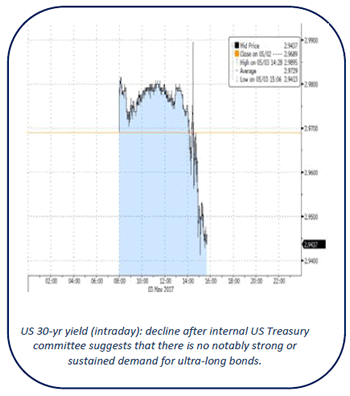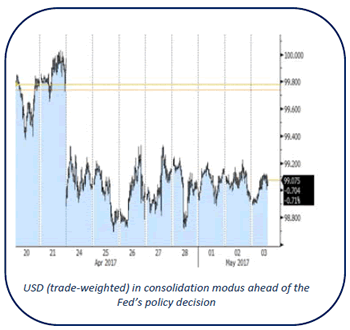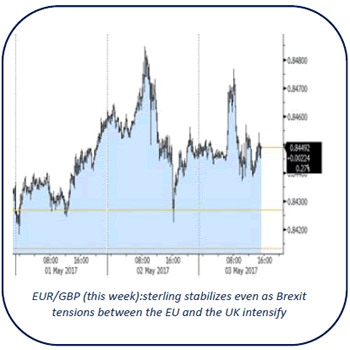Headlines
European equity markets record small losses in an uneventful session, ignoring strong EMU Q1 GDP numbers. US stock markets open with in negative territory with Nasdaq underperforming following profit taking in Apple shares after yesterday’s mediocre earnings.
America’s service industries expanded more than projected in April as a measure of orders reached the highest level since 2005 (63.2). The non-manufacturing ISM rose from 55.2 to 57.5, much more than expected (55.8)
The EMU economy started the year with robust growth that outstripped that of the US and set the stage for a strong 2017. EMU GDP grew by 0.5 Q/Q in Q1, which translates to annualised growth of 1.8% in all of 2017, Eurostat said. The US recorded 0.7% annualised growth in Q1, the weakest performance since the first quarter of 2014.
German unemployment extended its four-year decline last month, suggesting companies are confident that momentum in Europe’s largest economy remains strong. The number of people out of work slid by a seasonally adjusted 15,000 to 2.543 million in April. The unemployment rate steadied at 5.8%, a multi-decade low.
The US private sector added 177,000 jobs last month according to ADP, representing a fall from the March pace (255,000), but slightly beating expectations (175,000). The data come ahead of the closely tracked monthly employment from the US labour department (payrolls) that is due for release on Friday.
There is little evidence of strong or sustainable demand for "ultra-long" US government bonds, an advisory committee to the US Treasury has concluded. The current administration has been looking at whether it should introduce new bond issuance that exceeds the current 30-yr maturity threshold. Treasury secretary Mnuchin said on Monday that it "could absolutely make sense for us at the Treasury".
Rates
Core bonds tread water ahead of Fed
Global core bonds treaded water today, bar some volatility around the weaker European equity market opening and around the time US Treasury Secretary Mnuchin spoke at a Community banker event. Mnuchin repeated his interest in issuing longer term debt and talked about first conclusions from an internal committee studying the issue. They said they didn’t see notably strong demand or sustainable demand for ultra-long bonds (>30y), but added that it makes sense to issue more long term debt (10y-20y-30y). On tax reforms, Mnuchin remains hopeful that they can be concluded this year. EMU (Q1 GDP) and US (ADP) eco data printed bang in line with consensus and couldn’t trigger action ahead of tonight’s FOMC meeting. The non-manufacturing ISM was very strong, including the forward-looking order component and caused a spike lower in US Treasuries, but the move lacked follow-through selling. EIA oil inventory data are a wildcard for global markets with oil prices near key support levels.
At the time of writing, changes on the US yield curve range between +1.6 bps (2-yr) and -2.3 bps (30-yr). The outperformance of the very long end of the curve is clearly due to the Mnuchin comments. The German yield curve shifts up to 0.9 bps lower. On intra-EMU bond markets, 10-yr peripheral spreads narrow 3-to-4 bps for Spain/Italy and 7 bps for Portugal. The Greek spread widens 3 bps.
The FOMC is expected to keep its policy rate unchanged (0.75%-1%) tonight. We don’t expect big changes to the policy statement. If the Fed doesn’t manage to keep June rate hikes expectations near current levels (70%) eg by stressing weak Q1 GDP too much or referring to the continued need of strong eco data, the US Note future could revisit the 126-20 contract high short term. We would use such move to enter new short positions. Friday’s avalanche on Fed speakers could "correct" a soft market reaction by confirming the intention to continue the gradual tightening pace, a similar scenario as between the February and March FOMC meetings. A hawkish Fed – clear reference to June tightening and/or balance sheet tapering -, not our preferred scenario, would trigger immediate selling.
The German Finanzagentur tapped the on the run 10-yr Bund (€3B 0.25% Feb2027). Total bids remained low (€3.65B), compared with the €3.97B average at the previous 4 Bund auctions. The Bundesbank set aside a relatively large part (€0.57B; 19%) of the amount on offer for secondary market operations, resulting in an official bid cover of 1.5 (real bid cover 1.2). The auction had no tail.

Currencies
Fed to decide on next USD move?
Trading in EUR/USD and USD/JPY was still locked in tight ranges as investors awaited guidance from the Fed policy statement later this evening. EMU growth was strong, as expected and US ADP job growth OK. However, the data hardly impacted FX trading. EUR/USD is trading in well-known territory in the 1.0910/20 area. USD/JPY is holding near the recent top in the 112.35 area.
European equities opened with modest losses, but soon settled in directionless sideways trading. The EMU eco data were solid, as expected. The EMU economy expanded by 0.5% Q/Q and 1.7% Y/Y. The German April unemployment declined slightly more than expected (-15k). The market reaction to these kind of EMU data was close to non-existent, as usual. The dollar gained a few ticks against the euro and against the yen early in European trading. We consider it a cautious, insignificant market repositioning going into the Fed policy decision.
The US ADP private job report came out close to expectations at 177 000. It suggests that the labour market remains reasonably healthy. However, just hours before the Fed meeting, the report failed to inspire USD trading. EUR/USD continues to trade in the 1.0920 area going into the publication of the US nonmanufacturing ISM. USD/JPY remained well bid and is again testing the recent highs in the 112.20/35 area. Contrary to the manufacturing measure earlier this week, the US non-Manufacturing ISM was very strong at 57.5 (from 55.2, 55.8 was expected). The dollar (especially USD/JPY) tries to gain some further ground immediately after the release.
The countdown to the FOMC decision continues. We don’t expect a big change in the Fed’s assessment. However, if the Fed elaborates on recent US data softness, it might be a slightly USD negative, even if the FOMC keeps the option of a June rate hike open.

No further sterling losses despite Brexit nervousness
Sterling was under pressure at the start in Europe this morning. An FT article indicated that the EU could demand the UK a ‘separation charge’ of up to €100B. The report followed other recent signals that the UK and the EMU might be heading for very tough Brexit-negotiations. EUR/GBP touched an intraday top of 0.8476. Cable spiked to the 1.2885 area. However, this time there was no followthrough sterling selling. The UK April construction PMI rebounded to 53.1 from 52.2 (52.0 was expected). The release is not that important for markets, but it helped to put a floor for sterling even as the political bickering between the EU and the UK continues with more harsh comments from EU’s Barnier and UK Brexit Minister Davis. EUR/GBP dropped to the 0.8450 area. Cable returned to the 1.29+ area. Both cross rates are still trading in that area.














